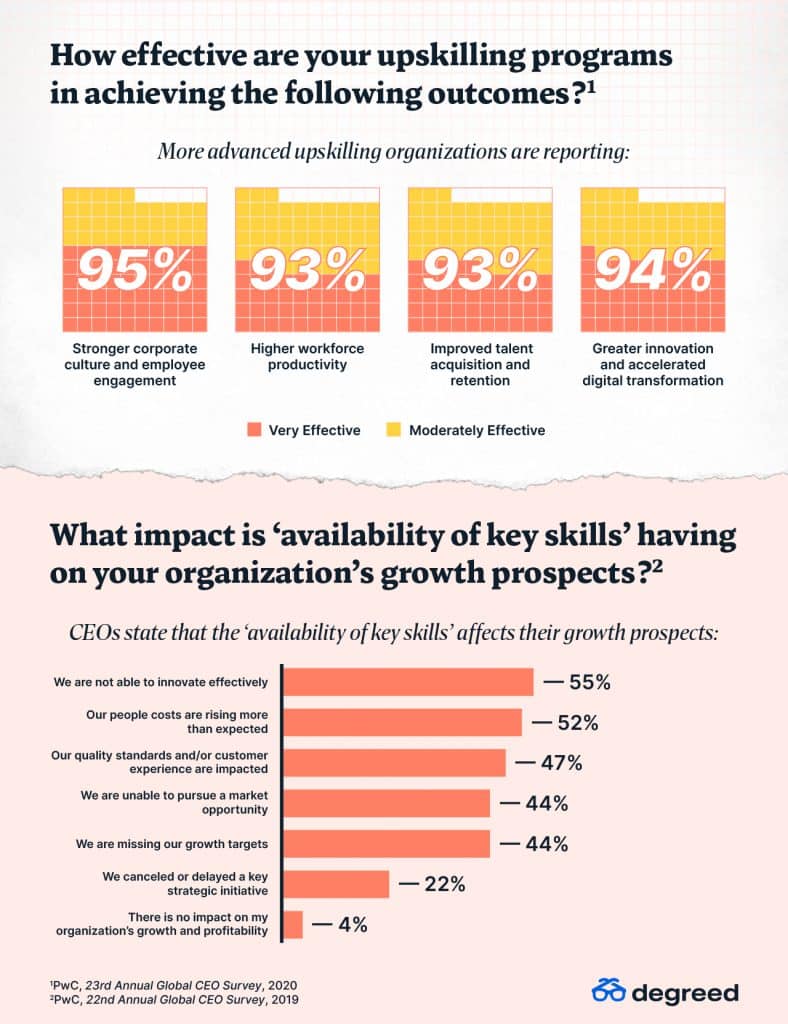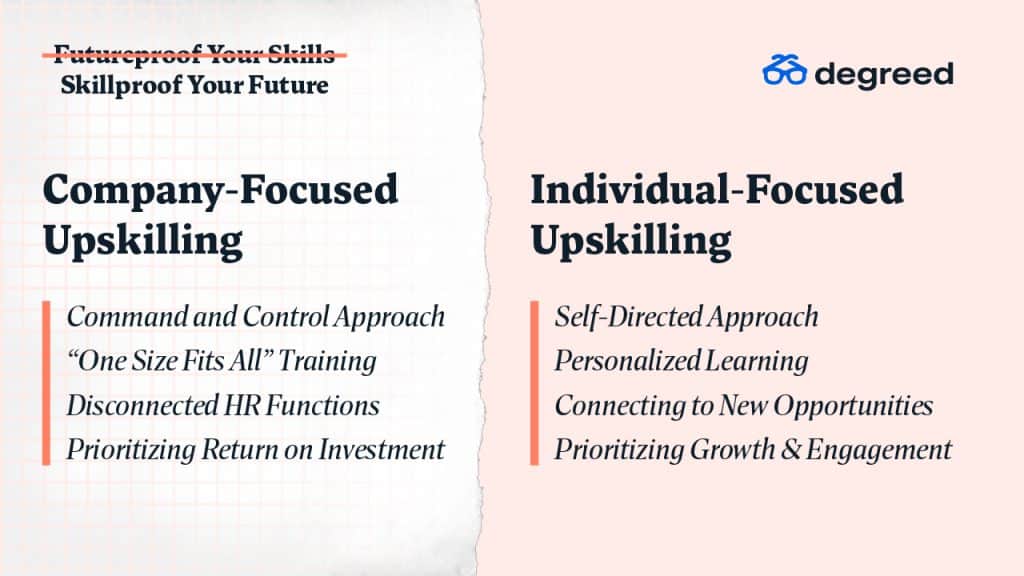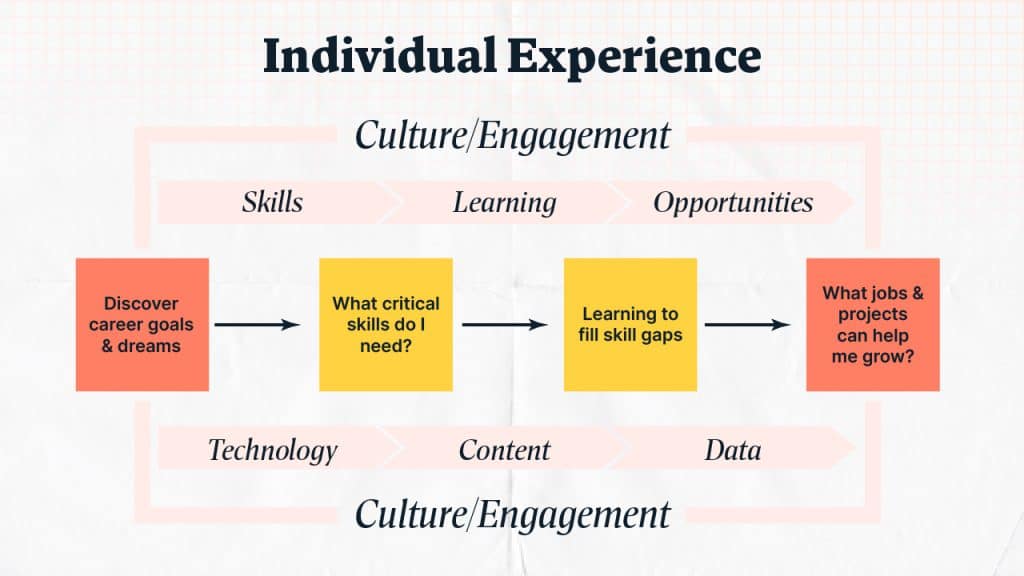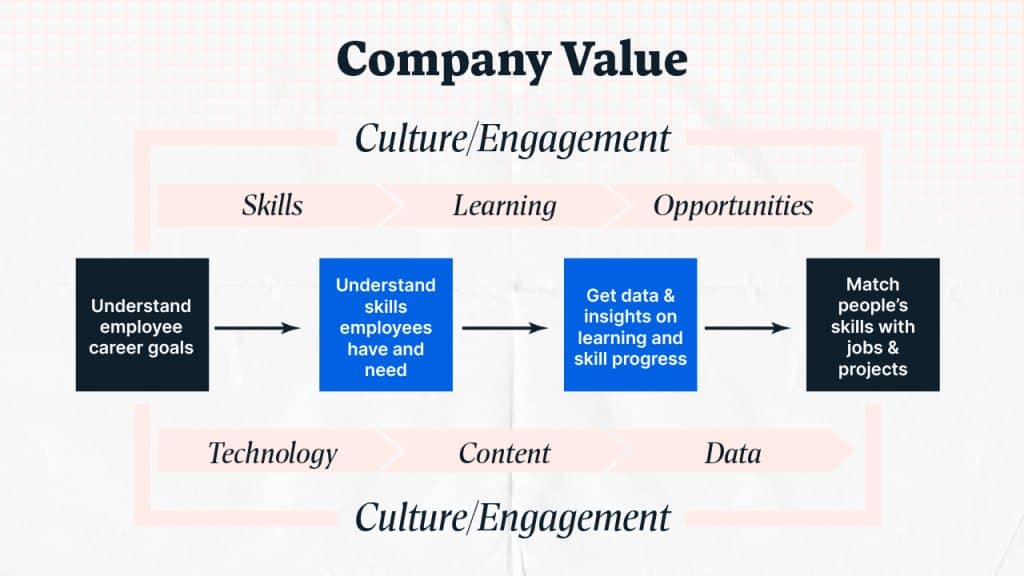Every executive knows that skills can make or break their business. Availability of key skills is a perennial top threat in PwC’s Annual Global CEO Survey. And yet, most leaders have not figured out how to build skills at scale. In fact, only 18% of those CEOs reported “significant progress” in their upskilling efforts.
The benefits of upskilling are huge. PwC found that successful skill-building programs lead to stronger culture, higher productivity, and accelerated innovation. Effective upskilling also makes it easier to attract and retain talent.
The perils of ignoring a skill strategy are notable, too. CEOs struggling with the skills gap are worried about missed market opportunities, rising talent costs, stunted growth, and a lack of innovation. They also expect quality standards and customer experience to suffer.

Mastercard has proven how effective upskilling pays off. Facing fintech startups in the wake of the recession, CEO Ajay Banga insisted that this payments company would become a technology company. Mastercard’s L&D team responded by revolutionizing its digital offerings, especially for the crucial Operations & Technology division. From 2016 to 2019, employee adoption of digital learning climbed steadily to 96% and the average number of learning platform logins per employee tripled.
In that same timespan, Mastercard’s stock price tripled too, as the company broke through in key areas like mobile payments and cybersecurity. Was the stock surge just a coincidence? The learning leadership doesn’t think so. “That represents Mastercard having the right skills and people to explore new payment technologies,” declared Steve Boucher, the VP of Global Talent Development.
Time to Shift the Paradigm
If the benefits of upskilling are so obvious, why aren’t most companies making progress? The problem is the paradigm. For too long, upskilling has focused on the company, not the individual.
The old models of work typically centered on the company. Leaders relied on a “command and control” management style, forcing employees into “one size fits all” training programs. Companies wanted to dictate when, how, and what people learned and tried to tie a predictable return on investment (ROI) calculation based primarily on employee participation. Decades of research have shown how ineffective this approach has been.
These days, leading analysts like Deloitte’s Center for the Edge are calling for a new model of work that puts individuals at the center. As artificial intelligence and machine learning make uniquely human capabilities more valuable, companies can no longer treat people like interchangeable parts. Workers thrive with variety, fluidity, and autonomy.
Focusing on individuals will transform upskilling efforts. Employees can direct their own development, recognizing and addressing personal skill gaps. Employers can get real-time data and insights about people’s skills and can make it easy for people to find projects and positions that match emerging skills, rewarding the workers who learn and grow within the company. In this paradigm, people can easily see the link between their learning and the skills they are building for their careers creating a more engaged, purposeful, and impactful workforce.

Align Individual Experience with Company Value
When organizations are effective with upskilling, the approach aligns the individual experience with value for the company.
The individual upskilling experience starts with each employee’s aspirations. Once it’s clear what people want, you can start conversations about the skills they’ll need to get there. Personalized learning platforms like Degreed make it easy to deliver content to close their skill gaps by leveraging data generated by its users. Then, individuals can put new skills into practice with stretch assignments, become more well-rounded as workers, and even take on entirely new roles within the company.

Focusing on individuals also creates value for companies. Affirming employees’ career goals helps establish trust so you can have an open conversation about strengths and weaknesses.
As workers learn on digital platforms like Degreed and strategic learning programs from your company, leaders can track progress via data dashboards and use the insights to inform supportive check-ins. The end result is a win-win: internal mobility rewards loyal workers and is often far more efficient than hiring outside talent.

Five Changes to Make in Your Organization
Alright, let’s get into the details. What specific shifts will support an effective upskilling strategy focused on individuals? To get started, try these five adjustments in the following key areas:
1. Recruiting: from external talent to internal talent.
External hires are costly and risky. But internal mobility can improve retention and accelerate the learning process. Deloitte found that 76% of top talent acquisition teams look to hire internally, compared to just 17% of low-performing teams.
2. Capacities: from static competencies to dynamic skills.
Many people don’t know the difference between competencies and skills. Competencies usually include attitudes and behaviors. Skills, on the other hand, reflect transferrable expertise. Competency models were designed to keep people in one role, but shifting to a skills strategy can enable much greater flexibility for individuals and organizations.
3. Performance management: from top-down evaluation to employee experience feedback.
Managers are key to helping their employees build skills and progress in their careers. This all starts with having a career conversation. In addition, when employees know what’s expected of them, when they can use their strengths every day at work, and when they are recognized and rewarded for the great work they do, it’s an all-around win. Finally, managers should help employees find projects and stretch assignments so people can actually apply the skills they’ve learned. This may even lead to a completely new role inside the company. The role of managers in effectively upskilling the workforce is to focus on being “career coaches” and helping people grow and thrive in the company. Yet, many managers are not tuned in to their team’s development. To compensate, I recommend asking for feedback on employees’ experiences. Do they have clear expectations? Are they using their strengths and earning recognition? Can they find opportunities to grow?
4. L&D: from one size fits all training to a continuous skill strategy.
For generations, companies trained large groups on discrete objectives. Teams gathered to learn a management technique or the latest software program. But this approach could never keep pace with digital disruption. Now top firms like Unilever are using digital tools to create a lifelong learning ecosystem. Workers are always exploring and building the emerging skills that they’ll need for their unique journeys.
5. Career development: from high-potential programs to building skills for everyone.
In the days of pricey in-person training, many employers treated career development as a perk for “high-potential” employees. This exclusionary approach had predictable downsides, making participants more entitled and alienating those who didn’t get invited. As online platforms drive down the cost of upskilling at scale, it’s time to get more inclusive. Looking for a model? One major bank pioneered a genius “funnel” approach that lets people prove their own potential.
Time to Take the Next Steps
If you’re ready to get started, check out 7 Steps for Upskilling Your Workforce for a clear framework on how you can build an effective upskilling strategy.

Skills are the key to the future. The only question is which organizations will be effective with upskilling. Now is the time for a strategy that elevates the individuals who make your organization great.
